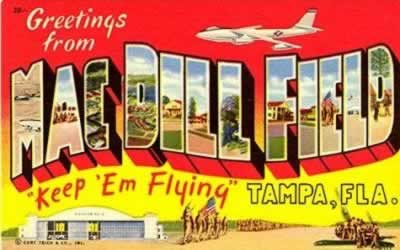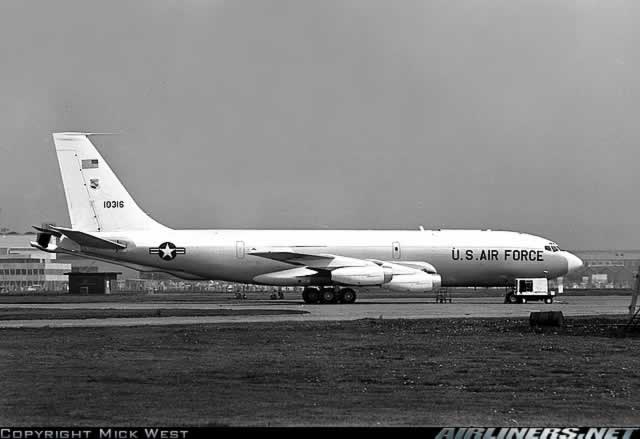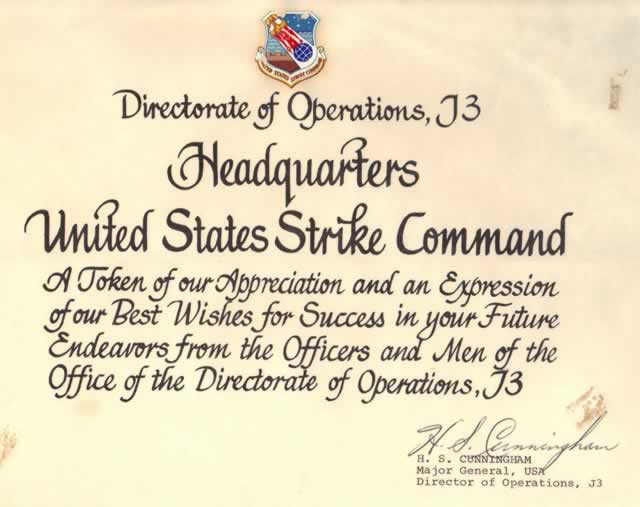U.S. Strike Command
My Connections with STRIKE
From 1969-1971, I served with the United States Strike Command at MacDill Air Force Base in Tampa.
 Patch of the United States Strike Command |
During my time with the J3 Command and Control Division, I had the distinct honor of serving under Army General John L. Throckmorton, Strike Commander in Chief, Air Force General Benjamin O. Davis, Deputy Commander in Chief, and Army Major General George P. Seneff, Jr., Director of Operations (J3).
My two years of service at Strike were among the finest years of my life, and I thoroughly enjoyed working side by side with military personnel of the U.S. Air Force, Army, Navy and Marines.
I took part in various military exercises, including one at Langley AFB in Hampton, Virginia, making the flight from MacDill in a Lockheed C-130 Hercules with one of my co-workers as pilot. I also had the distinct privilege of flying into Andrews AFB in Washington, and repesenting my work group at the funeral of one of my co-workers, an Army Major, at Arlington National Cemetery. The trip to/from DC was in the Strike Command's modified VC-135A.
MacDill had a long history before I arrived, and today continues to serve the defense needs of the United States. A brief history of MacDill AFB is included on this website.
 Greetings from MacDill - Home of the U.S. Strike Command |
MacDill AFB History: The Early Years
The land at the south tip of Interbay Peninsula was given to the War Department in 1939 by the State of Florida and Hillsborough County. The air field, originally known as Southeast Air Base, Tampa, was dedicated as MacDill Army Air Field in 1941. Named in honor of Colonel Leslie MacDill, a World War I aviator killed in the line of duty, the facility became MacDill Air Force Base in 1948.
U.S. Strike Command
In response to the Cuban Missile Crisis, the United States Strike Command was established at MacDill in 1961 as a crisis response force, one of the first "unified commands", a command that draws manpower and equipment from all branches of the U.S. military.
 Logo of the United States Strike Command |
The name of the command was derived from the acronym for Swift Tactical Reaction In Every Known Environment (STRIKE).
In 1972, Strike Command was renamed United States Readiness Command. In 1983, the new Rapid Deployment Joint Task Force (RDJTF) was activated, and in 1987 it became U.S. Central Command (CENTCOM).
I clearly remember my first and only flight on Strike's VC-135A, circa 1970, from MacDill to Andrews AFB, and returning. Several members of Strike J3-CD, representing different military services, were flown to DC to attend the funeral services for one of our co-workers, an Army major. As I recall, there was seating for only about a dozen passengers. As a young Naval officer, it was an honor to participate in the service.
The plane, S/N 61-0316, was a Boeing KC-135A converted (I believe it was in 1967) into the airborne command post for the Strike Command Commander in Chief. It was stationed at MacDill until 1975, modified back to tanker configuration in 1979, and assigned to Barksdale Air Force Base in Louisiana for use by the 8th Air Force Commander. It burned on the ground during refueling in Cairo, Egypt on March 19, 1985.
U.S. Strike Command's VC-135A, S/N 61-0316, Airborne Command Post, built in 1962
Photo taken at Heathrow Airport near the PanAm hangar, 1971
(Photo by Mick West, as published by Airliners.Net ... used with permission of the photographer)


View a movie about the STRIKE Command at the Internet Archive

